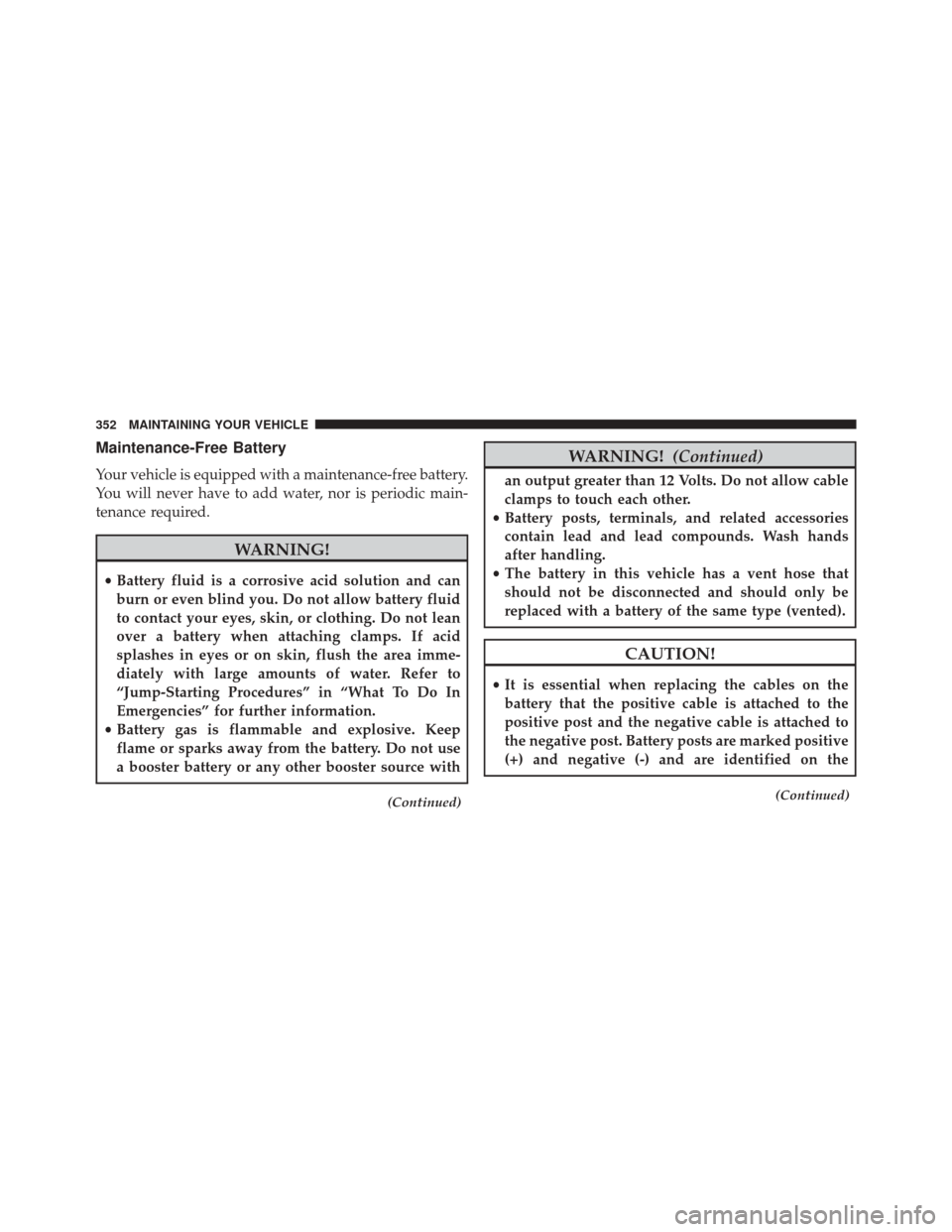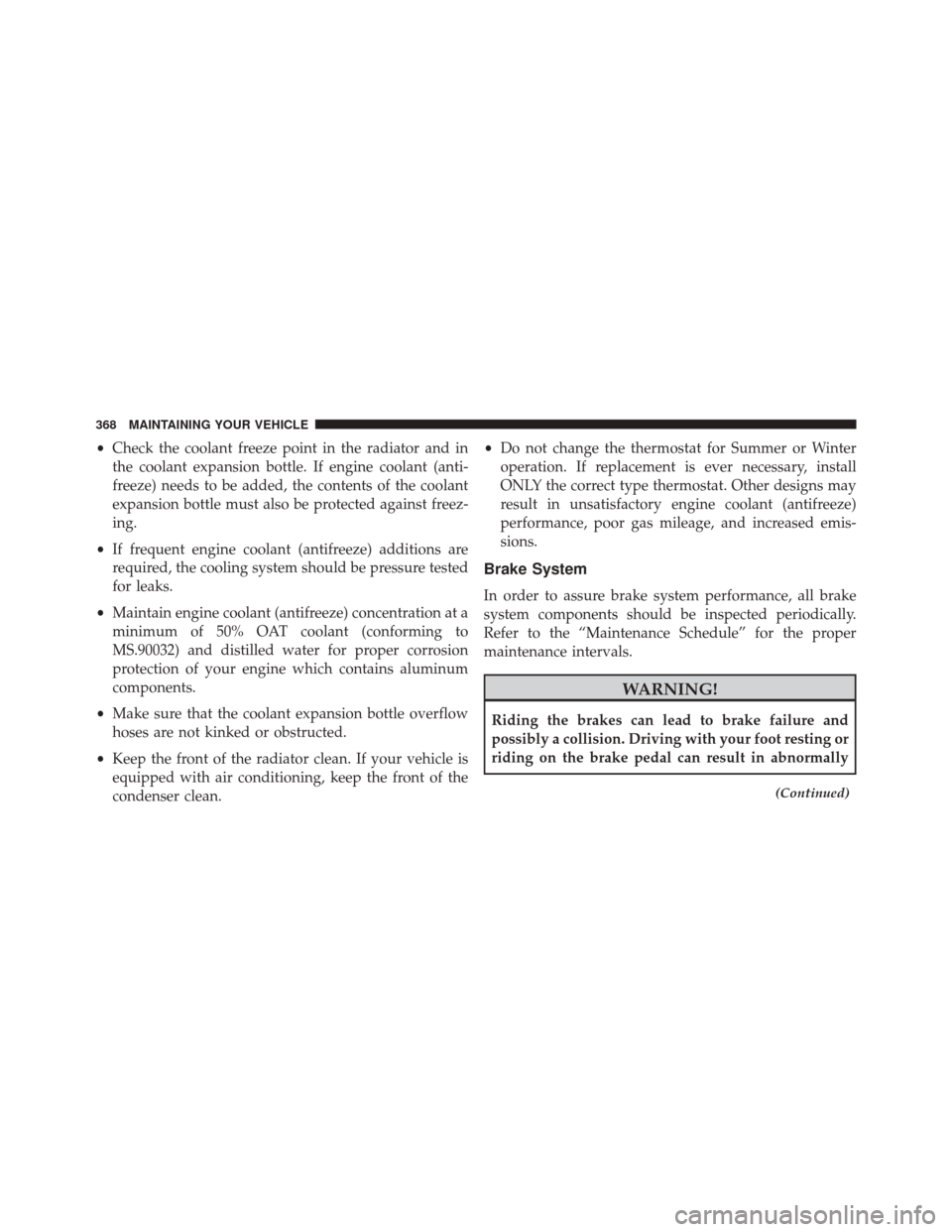Page 45 of 432

WARNING!(Continued)
some collisions, air bags won’t deploy at all. Al-
ways wear your seat belts even though you have air
bags.
Advanced Front Air Bag Operation
Advanced Front Air Bags are designed to provide addi-
tional protection by supplementing the seat belts. Ad-
vanced Front Air Bags are not expected to reduce the risk
of injury in rear, side, or rollover collisions. The Ad-
vanced Front Air Bags will not deploy in all frontal
collisions, including some that may produce substantial
vehicle damage — for example, some pole collisions,
truck underrides, and angle offset collisions.
On the other hand, depending on the type and location of
impact, Advanced Front Air Bags may deploy in crashes
with little vehicle front-end damage but that produce a
severe initial deceleration. Because air bag sensors measure vehicle deceleration
over time, vehicle speed and damage by themselves are
not good indicators of whether or not an air bag should
have deployed.
Seat belts are necessary for your protection in all colli-
sions, and also are needed to help keep you in position,
away from an inflating air bag.
When the ORC detects a collision requiring the Ad-
vanced Front Air Bags, it signals the inflator units. A large
quantity of non-toxic gas is generated to inflate the
Advanced Front Air Bags.
The steering wheel hub trim cover and the upper right
side of the instrument panel separate and fold out of the
way as the air bags inflate to their full size. The Advanced
Front Air Bags fully inflate in less time than it takes to
blink your eyes. The air bags then quickly deflate while
helping to restrain the driver and front passenger.
2
THINGS TO KNOW BEFORE STARTING YOUR VEHICLE 43
Page 229 of 432

�TIRES — GENERAL INFORMATION ........274
▫ Tire Pressure ....................... .274
▫ Tire Inflation Pressures .................276
▫ Tire Pressures For High Speed Operation . . . .277
▫ Radial Ply Tires ..................... .278
▫ Tire Types .......................... .278
▫ Run Flat Tires — If Equipped .............280
▫ Spare Tires — If Equipped ...............280
▫ Tire Spinning ....................... .283
▫ Tread Wear Indicators ..................283
▫ Life Of Tire ........................ .284
▫ Replacement Tires .....................285
� TIRE CHAINS (TRACTION DEVICES) .......287�
TIRE ROTATION RECOMMENDATIONS .....287
� TIRE PRESSURE MONITORING SYSTEM
(TPMS) ............................. .288
▫ Premium TPM System With Comfort Cluster . .291
▫ Premium TPM System With (TFT) Tire Pressure
Display Screen ....................... .293
▫ General Information ...................297
� FUEL REQUIREMENTS ..................297
▫ Reformulated Gasoline .................298
▫ Gasoline/Oxygenate Blends ..............298
▫ E-85 Usage In Non-Flex Fuel Vehicles .......299
▫ MMT In Gasoline .....................299
▫ Materials Added To Fuel ................299
▫ Fuel System Cautions ...................300
5
STARTING AND OPERATING 227
Page 354 of 432

Maintenance-Free Battery
Your vehicle is equipped with a maintenance-free battery.
You will never have to add water, nor is periodic main-
tenance required.
WARNING!
•Battery fluid is a corrosive acid solution and can
burn or even blind you. Do not allow battery fluid
to contact your eyes, skin, or clothing. Do not lean
over a battery when attaching clamps. If acid
splashes in eyes or on skin, flush the area imme-
diately with large amounts of water. Refer to
“Jump-Starting Procedures” in “What To Do In
Emergencies” for further information.
• Battery gas is flammable and explosive. Keep
flame or sparks away from the battery. Do not use
a booster battery or any other booster source with
(Continued)
WARNING! (Continued)
an output greater than 12 Volts. Do not allow cable
clamps to touch each other.
• Battery posts, terminals, and related accessories
contain lead and lead compounds. Wash hands
after handling.
• The battery in this vehicle has a vent hose that
should not be disconnected and should only be
replaced with a battery of the same type (vented).
CAUTION!
• It is essential when replacing the cables on the
battery that the positive cable is attached to the
positive post and the negative cable is attached to
the negative post. Battery posts are marked positive
(+) and negative (-) and are identified on the
(Continued)
352 MAINTAINING YOUR VEHICLE
Page 370 of 432

•Check the coolant freeze point in the radiator and in
the coolant expansion bottle. If engine coolant (anti-
freeze) needs to be added, the contents of the coolant
expansion bottle must also be protected against freez-
ing.
• If frequent engine coolant (antifreeze) additions are
required, the cooling system should be pressure tested
for leaks.
• Maintain engine coolant (antifreeze) concentration at a
minimum of 50% OAT coolant (conforming to
MS.90032) and distilled water for proper corrosion
protection of your engine which contains aluminum
components.
• Make sure that the coolant expansion bottle overflow
hoses are not kinked or obstructed.
• Keep the front of the radiator clean. If your vehicle is
equipped with air conditioning, keep the front of the
condenser clean. •
Do not change the thermostat for Summer or Winter
operation. If replacement is ever necessary, install
ONLY the correct type thermostat. Other designs may
result in unsatisfactory engine coolant (antifreeze)
performance, poor gas mileage, and increased emis-
sions.
Brake System
In order to assure brake system performance, all brake
system components should be inspected periodically.
Refer to the “Maintenance Schedule” for the proper
maintenance intervals.
WARNING!
Riding the brakes can lead to brake failure and
possibly a collision. Driving with your foot resting or
riding on the brake pedal can result in abnormally
(Continued)
368 MAINTAINING YOUR VEHICLE
Page 420 of 432

Electronic Speed Control (Cruise Control)........110
Electronic Stability Control (ESC) ..............257
Electronic Throttle Control Warning Light ........156
Electronic Vehicle Information Center (EVIC) ......178
Exit Trip ............................. .182
NewTrip ............................ .182
Start Of Trip Procedure ...................182
Trip Computer ........................ .181
Trip Functions ........................ .183
Emergency, In Case Of Hazard Warning Flasher ..................309
Jacking .............................. .323
Jump Starting ......................... .331
Towing ............................. .338
Emission Control System Maintenance ..........345
Engine Air Cleaner .......................... .351
Break-In Recommendations .................74
Checking Oil Level ..................... .348Compartment
......................... .343
Cooling ............................. .363
Exhaust Gas Caution ..................76, 301
Fails To Start ......................... .231
Flooded, Starting ...................... .231
Fuel Requirements ..................... .297
Oil ............................. .348, 393
Oil Filler Cap ......................... .350
Oil Filter ............................ .350
Oil Selection ...................... .349, 394
Overheating .......................... .309
Starting ............................. .229
Enhanced Accident Response Feature ............50
Ethanol ............................... .298
Euro Twin Clutch Transmission Fluid Type ........................... .371
Event Data Recorder ........................54
Exhaust Gas Caution ....................76, 301
Exhaust System ....................... .76, 360
418 INDEX